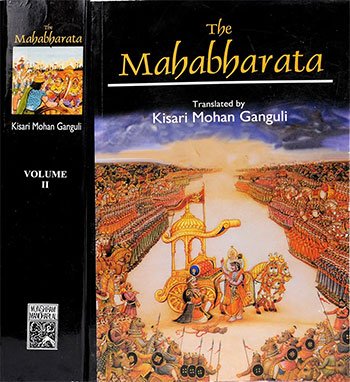Section X - Life in Bharatavarsha: Yugas, Ages, and Attributes in Detail
Book index: Mahabharata (English)
This page contains a summary of the Mahabharata Section X including examples of moral lessons in daily life. The Maha-Bharata is one of the largest epics ever written containing roughly 100,000 Sanskrit verses. It deals with the legendary history of ancient India and contains a large number of interwoven tales.
Short summary of the chapter:
Dhritarashtra asks Sanjaya to describe the different ages (Yugas) in Bharata Varsha, the strengths and weaknesses of the residents, and the characteristics of each age. In the Krita age, people live for four thousand years and are virtuous, wise, and powerful. In Treta, the lifespan decreases to three thousand years, and Kshatriyas are brave rulers of vast empires. In Dvapara, people live for two thousand years and are capable of great exertion and energy. However, in Kali Yuga, there is no fixed limit to life span, and people are characterized by jealousy, anger, and deception. Despite the decline in qualities, Harivarsha is considered superior to Haimavatvarsha and Bharatavarsha in the current age of Dvapara.
Full English translation:
This page is merely a summary which is automatically generated. If you are looking for authentic sources such as the Sanskrit text or the Full English translation of Mahabharata Section X - Life in Bharatavarsha: Yugas, Ages, and Attributes in Detail, have a look at the following articles:
Section X, online text
English translation by Kisari Mohan Ganguli.
Read this and other chapters online.
Mahabharata (English Summary)
by Kisari Mohan Ganguli | ISBN-10: 8121505933
Buy the latest edition:
FAQ of Mahabharata, Section X:
What are the characteristics of the four Yugas mentioned in the story?
The four Yugas are Krita, Treta, Dvapara, and Kali, each with varying attributes. People in Krita are virtuous, while those in Kali are wrathful and deceitful.
How does the behavior and lifespan of people differ across the four Yugas?
In Krita, people live for 4,000 years, while in Kali, life spans are shorter. People in Krita are virtuous, while those in Kali are characterized by jealousy and deceit.
Daily life: Life in Bharatavarsha: Yugas, Ages, and Attributes in Detail:
The passage tells us about the four Yugas (ages) and their characteristics, emphasizing how human qualities and life spans change over these periods. In our daily lives, we can draw inspiration from this by aiming to embody the virtues of the Krita age, where wisdom, strength, and virtue were prevalent. Even though we live in times that may resemble the Kali age, known for its challenges and lesser virtues, we possess the power to strive for the higher qualities of honesty, bravery, and ascetic wealth.
Understanding that each Yuga brings its unique challenges and opportunities, we can focus on cultivating resilience and wisdom to navigate our times better. By acknowledging the traits of the current age, such as jealousy and anger, we can work consciously to counteract these with compassion, truthfulness, and self-discipline. Embracing the positive attributes from each Yuga and integrating them into our lives can lead to personal fulfillment and contribute towards creating a more harmonious society.
In essence, the story encourages us not to be swayed by the negative tendencies of our age but to aspire for a higher standard of conduct and self-improvement, reflecting the best qualities of all ages.
